Location of Insurance Industry Investments 2017
Author: MAPFRE Economics
This article provides a comparative view of the placement of insurance companies, by asset type, in a selection of markets, including both developed markets (the Eurozone, United States, United Kingdom and Spain) and emerging ones (Brazil and Mexico) as at the close of 2017. This analysis provides an overall impression of the risk profile of their portfolios, based on the proportions of the main categories of assets in each market’s combined investment portfolio.
Moreover, it includes an analysis of the investment portfolios of a selection of international insurance groups, based on data gathered from their 2018 consolidated accounts. This analysis also offers comparative information about the rating of fixed income assets and the changes compared to the previous year, in order to provide a more in-depth view when comparing their risk profiles.
Whenever possible, the information presented distinguishes between the “traditional” investment portfolio (in which investment risk is locked into the balance sheets of the various insurance companies) and portfolios promoting products in which it is the person taking out the insurance who assumes the investment risk (products of the unit-linked type). Thus, once the traditional investment portfolio has been defined, the proportions corresponding to each category of assets are then shown.
Placement of investments at market level
Charts 1-a and 1-b provide an idea of the size of the investment portfolios of all the insurance companies in the markets analyzed and their relative importance in relation to GDP. It follows from this information that the combined value of the investment portfolios for the sample of markets analyzed totaled 16 trillion euros in 2017, representing significant percentages of GDP in the respective markets, the most notable case being the United Kingdom, where this ratio was 105%.
As has been highlighted in other analyses prepared by MAPFRE Economic Research, from this information it emerges that the insurance industry is one of the largest institutional investors at global level. Suffice to say that the insurers in the selected markets manage a volume of assets that is greater than the combined GDP of all the Eurozone countries, and only slightly less than the GDP of the United States. By exercising this function, the insurance industry contributes to the consolidation of capital through a stable resource inflow for the long-term financing of projects that promote economic growth, also bringing stability to the financial system by providing a steady source of financing that reduces pro-cyclicality at times of crisis.
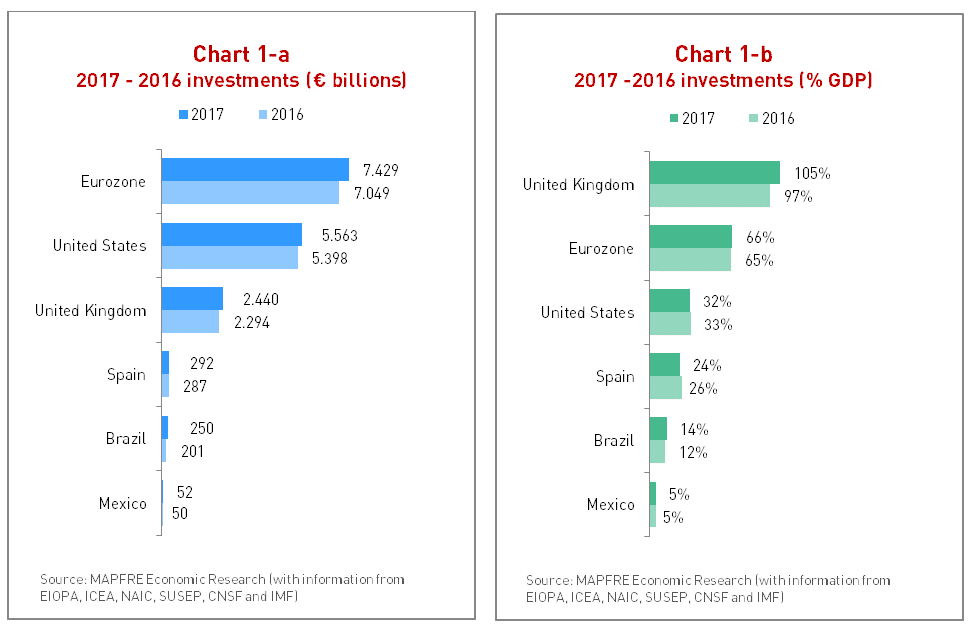
In Chart 1-a it can be seen that the volume of investments managed increased in absolute terms in all the markets analyzed, compared to the previous year. However, measured in relative terms, in Spain and the United States there was a reduction in the proportion of the investments managed in relation to the size of their respective economies, measured in terms of GDP (see Chart 1-b). The relative proportions of the other markets increased, with the highest increase experienced by the United Kingdom (+8 percentage points), followed by Brazil (+2 percentage points).
Also worth noting is that the proportion of investments managed by insurance companies in relation to GDP is considerably higher in developed markets than in emerging markets. This is explained by the limited development of the Life business in the latter, which is an indicator of the future potential these markets display for this line of business.
Portfolios linked to traditional business compared to unit-linked business
Table 1 shows the proportion of traditional and unit-linked business, in markets where the data available allows for this distinction to be made.
Table 1
Distribution of investment portfolios (traditional vs unit-linked business)

In general, it can be said that a higher proportion of unit-linked business is an indicator of the degree of sophistication of insurance markets, with the United Kingdom presenting the highest proportion (more than 54% of its total portfolio), followed by the United States, with unit-linked accounting for 30% of its portfolio in 2017. In all the markets shown, increases can be seen in the proportion of products in which those taking out the insurance assume the risk of the investment (unit-linked type) over the two years analyzed, except in the United Kingdom, where the percentage remained similar.
Meanwhile, Table 2 shows the breakdown of the portfolio of investments allocated to traditional business, and Table 3 the changes in the composition of portfolios in the years analyzed.
Table 2
Breakdown of investment portfolios (traditional business)
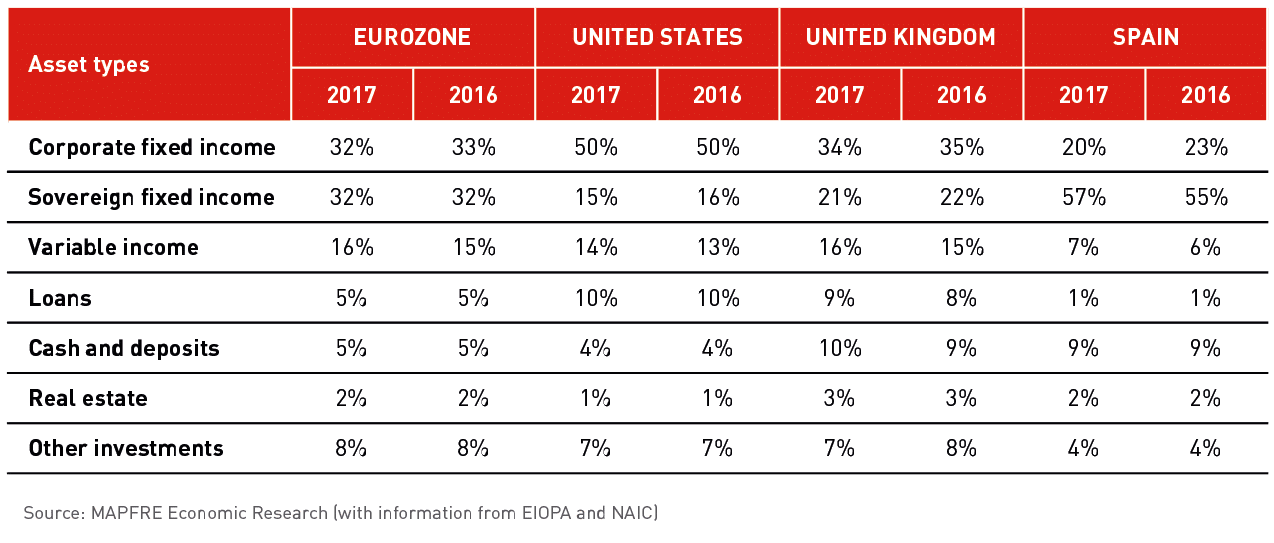
Table 3
Changes in the composition of investment portfolios, 2017-2018
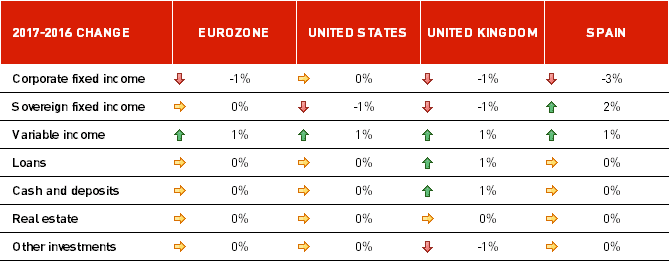
It can be seen that there has been a movement across the board in favor of higher-risk assets in the Eurozone, which can be attributed to the environment of continued low interest rates.
A similar shift can be seen in the United States, with a fall in investments in sovereign fixed income and an increase in variable income, which may have been influenced by forecasts of interest rate increases as part of the Federal Reserve’s process of monetary normalization, which increased the official interest rate fourfold during 2018.
In any case, it is important to note that no abrupt movements can be seen in the composition of the portfolios of the insurance companies in any of the markets analyzed, and that fixed income (sovereign and corporate) represents the highest proportion of investments. Unlike other financial institutions, the insurance business model calls for the implementation of liability-driven investment strategies, with the objective of achieving an adequate degree of bundling in terms of maturity and interest rates between the liabilities assumed and the investment instruments backing them up. This in turn creates restrictions when it comes to making significant replacements in their traditional business portfolios.
Moreover, the solvency regulation regimes in these markets are based on risks, consequently penalizing, in terms of regulatory capital, any movements toward higher risk levels. The final section of this article gives an idea of the relative proportions of capital risk weights applicable to the different categories of assets in the European Union.
Comparison of the structure of traditional portfolios in developed and emerging markets
In Table 4 it can be seen that, regardless of the preeminence of fixed income investments, the most developed markets present a higher percentage of risk assets in their traditional business portfolios, which is an indicator of their higher degree of sophistication. The fact that their financial and insurance markets are more developed means that they can offer a greater variety of savings-based insurance combining guaranteed interest rates with future discretionary benefits. It can be seen in Table 4 that the composition of the portfolio of the Spanish market more closely resembles those of the emerging markets, which is indicative of the low level of development of its life insurance market.
Table 4
Structure of portfolios in developed and emerging markets

Placement of investments at insurance group level
A selection of a sample of insurance groups providing sufficiently homogeneous information to make a comparison of their investment portfolios (including the ordinary portfolio, loans granted, cash and the investments allocated to unit-linked products) has been analyzed.
The information analyzed in Chart 2 shows that the two largest European groups in terms of these analysis criteria continue to be Allianz and Axa, which are head and shoulders above the rest. It is noteworthy that Generali is reducing in size, primarily due to the sale of its Generali Leben business.
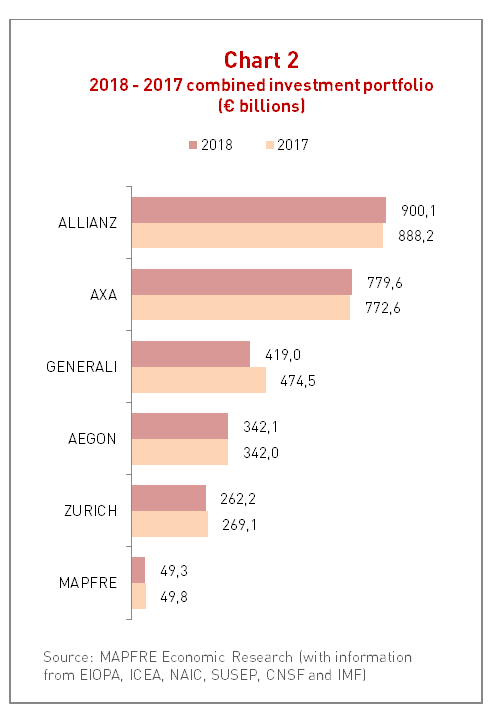
As is the case with a general analysis of the insurance markets, in the combined investment portfolio of the traditional business (excluding the unit-linked business) of these groups, corporate fixed income is predominant, representing 40.3% of investments (see Chart 3).
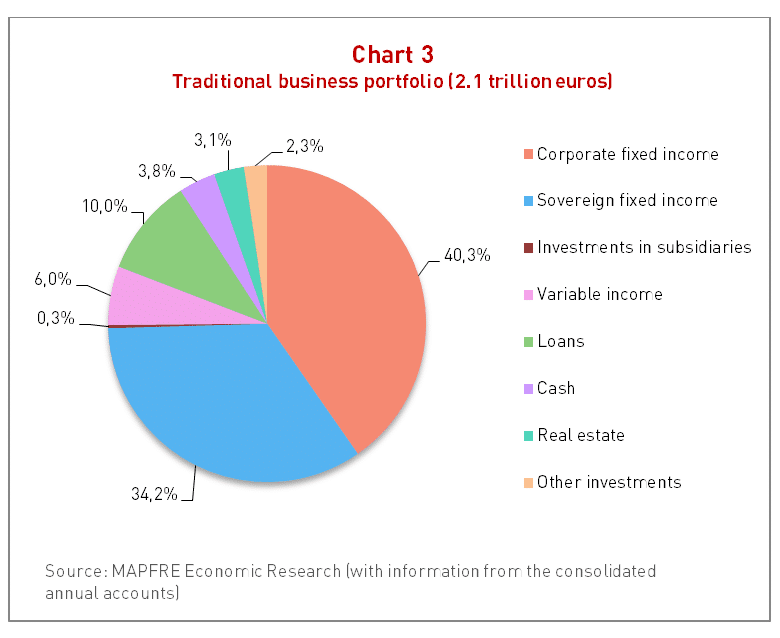
Sovereign fixed income at the close of 2018 represented 34.2% of the portfolio, with its weight declining by 1.05 percentage points compared to the close of the previous year (see Chart 4).
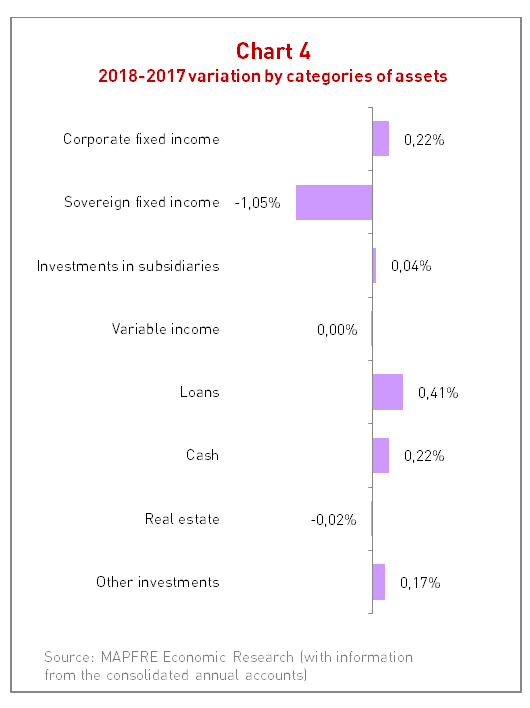
Table 5 shows the relative proportion at the close of 2018 of the different categories of assets for each of the insurance groups analyzed and their comparison with the previous year.
Table 5
Distribution of investment portfolios (traditional business), 2017-2018

Table 6 shows the changes in the composition of the portfolio of the respective groups by asset type between fiscal years 2017 and 2018.
Table 6
Changes in the composition of investment portfolios, 2017-2018
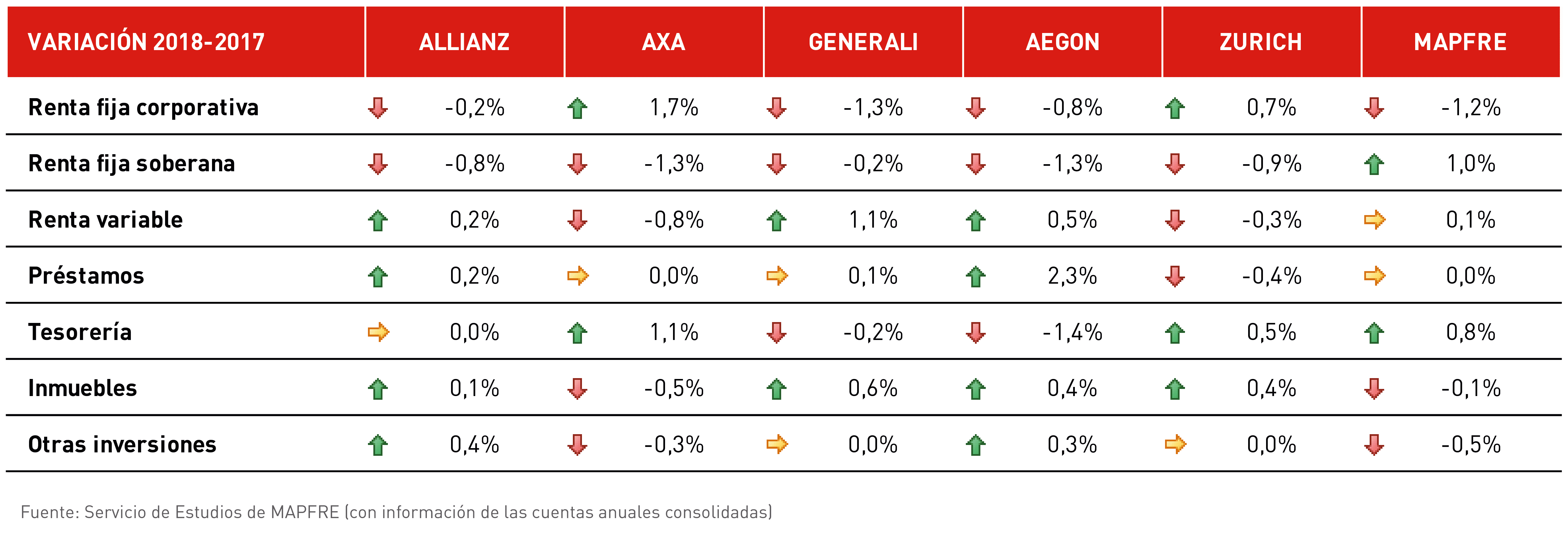
Unit-linked business in the major insurance groups
Finally, Chart 5 and Table 7 show the distribution of the investment portfolios between traditional business and business in which the person taking out the insurance assumes the investment risk (unit-linked and similar) for all the insurance groups included in the sample analyzed. In this regard, Aegon stands out, with its portfolio of unit-linked and similar business dominating its investment. In the case of the other insurance groups, portfolios linked to the traditional business prevail.
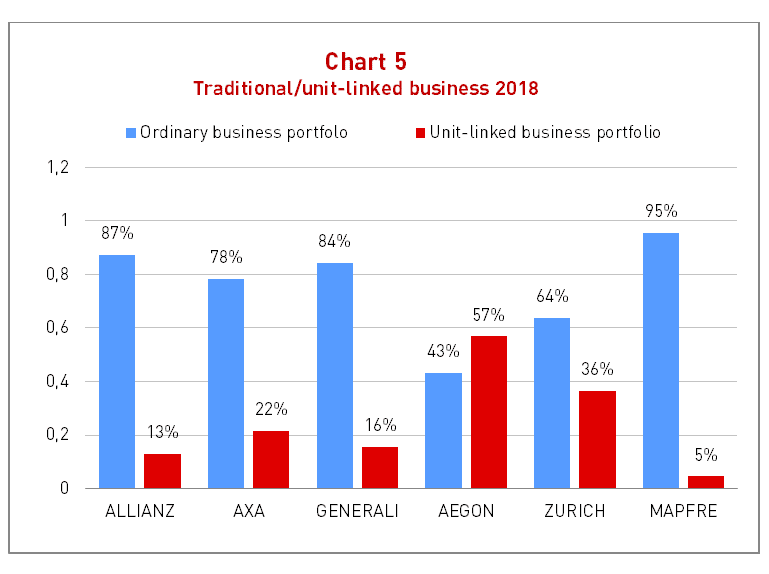
Table 7
Distribution of investment portfolios by type business, 2017-2018

Credit quality of the portfolios of the major groups analyzed
Table 8 summarizes the credit profiles of the investment portfolios with the highest level of disaggregation shown in the consolidated financial statements of the insurance groups analyzed, while Table 9 presents the changes in the credit profile of the portfolios’ investments.
Table 8
Credit rating of porfolios (traditional business), 2018

Table 9
Changes in credit quality, 2017-2018

In general, an improvement in credit quality can be seen in investments in sovereign fixed income. In this regard, the case of MAPFRE stands out, thanks to the improved sovereign rating assigned to Spain by the main ratings agencies in 2018.
However, the changes in credit rating of the corporate fixed income portfolios have, in general, been the opposite to that of sovereign debt, with the trend toward increases in their risk profiles.
The influence of capital risk weights on the composition of portfolios
Finally, a comparison of the gross regulatory capital risk weights by asset type is shown below. This is an obligatory requirement for insurance companies that apply the standard formula in Solvency II for the main categories of investments.
In this regard, Table 10 shows the capital risk weights by year of duration, applicable to investments in fixed income bonds. To calculate the total gross risk weight for a specific bond, its modified duration must be multiplied by the percentages appearing in the table. For durations of longer than five years, the percentages applicable for excessive duration are somewhat lower, with the objective of not penalizing excessively long-term investment.
Table 10
Gross capital risk weights applicable to bonds per year of duration under Solvency II

As can be deduced from this information, investments in sovereign bonds from countries in the European Economic Area (EEA) do not have capital risk weights for spread risk, provided that they are denominated and financed in their own currency. It is important to point out that these percentages are applied both to direct investments and to investments made through mutual funds, to which the so-called “look-through” approach is applied.
In the case of variable-income investment, the gross capital risk weight applicable to shares listed on markets regulated by the Organization for Economic Cooperation and Development (OECD) is 39% of the value of the shares concerned. Counter-cyclical symmetrical adjustments related to this weight are published monthly by the European Insurance and Occupational Pensions Authority (EIOPA).
The gross capital risk weight for market risk for real estate investments is 25% of the value of the property concerned. As in the case of other assets, this percentage is applied both to direct investments and to investments implemented through property mutual funds, to which the “look-through” approach is applied.
Finally, additional capital risk weights are applied if there are concentrated risks over and above specific thresholds and in the event of defective management of the risk of unbundling of cash-flows and/or currency provisions between assets and liabilities.




